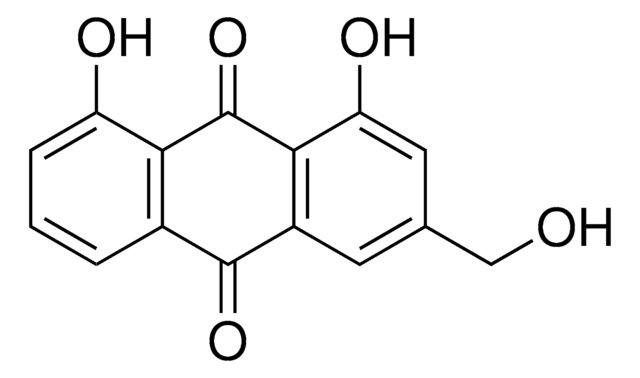93893
Physcion
analytical standard
Sinónimos:
1,8-Dihydroxy-3-methoxy-6-methylanthraquinone, 6-O-Methylemodin, 6-Methoxychrysophanic acid, Emodin-3-methyl ether, Parietin, Rheochrysidin
Seleccione un Tamaño
186,90 €
Precio de catálogo267,00 €Ahorre 30 %Seleccione un Tamaño
About This Item
186,90 €
Precio de catálogo267,00 €Ahorre 30 %Productos recomendados
grado
analytical standard
Nivel de calidad
Ensayo
≥98.0% (HPLC)
caducidad
limited shelf life, expiry date on the label
técnicas
HPLC: suitable
gas chromatography (GC): suitable
aplicaciones
food and beverages
Formato
neat
temp. de almacenamiento
2-8°C
cadena SMILES
COc1cc(O)c2C(=O)c3c(O)cc(C)cc3C(=O)c2c1
InChI
1S/C16H12O5/c1-7-3-9-13(11(17)4-7)16(20)14-10(15(9)19)5-8(21-2)6-12(14)18/h3-6,17-18H,1-2H3
Clave InChI
FFWOKTFYGVYKIR-UHFFFAOYSA-N
¿Está buscando productos similares? Visita Guía de comparación de productos
Categorías relacionadas
Descripción general
Aplicación
Acciones bioquímicas o fisiológicas
Envase
Productos recomendados
Palabra de señalización
Warning
Frases de peligro
Consejos de prudencia
Clasificaciones de peligro
Acute Tox. 4 Oral
Código de clase de almacenamiento
11 - Combustible Solids
Clase de riesgo para el agua (WGK)
WGK 3
Punto de inflamabilidad (°F)
Not applicable
Punto de inflamabilidad (°C)
Not applicable
Elija entre una de las versiones más recientes:
¿Ya tiene este producto?
Encuentre la documentación para los productos que ha comprado recientemente en la Biblioteca de documentos.
Los clientes también vieron
Filtros activos
Nuestro equipo de científicos tiene experiencia en todas las áreas de investigación: Ciencias de la vida, Ciencia de los materiales, Síntesis química, Cromatografía, Analítica y muchas otras.
Póngase en contacto con el Servicio técnico






